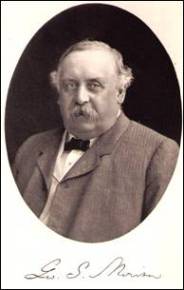
George S. Morison was born in New Bedford, Massachusetts on December 19, 1842, the son of a Unitarian Minister. He graduated from Harvard in 1863 with a BA and in 1866 with a degree in law. He went to work for a law firm in New York City and was admitted to the bar shortly after. He found the practice of law was not to his liking and decided to enter the field of civil engineering.
He was recommended to Octave Chanute who was appointed Chief Engineer on the construction of the first railroad bridge across the Missouri River at Kansas City, Missouri. Morison arrived at the site on October 16, 1867 and began his civil engineering career. Morison could not have found a better project, or a better mentor, to begin his career in civil engineering. A Kansas City newspaper reporting the opening of the bridge noted, "The method employed in building this pier #4, which is a great triumph of engineering, was suggested by the Chief Engineer, Mr. Chanute, but the details were all worked out by a young Massachusetts man, Mr. G. S. Morison, who bids fair to take a high rank among civil engineers." He then became Chanute's assistant on the Leavenworth, Lawrence and Galveston Railroad where he remained until June 1871. In July 1871 he was given his first job as chief engineer on the Detroit, Eel River and Illinois Railroad. After two years he followed Octave Chanute to the Erie Railroad as his chief assistant.
A major challenge came March 17, 1875 when a major ice jam took out the five-span, double track, bridge over the Delaware River near Port Jervis, New York. Morison, with the Watson Bridge Company of Paterson, New Jersey, replaced the structure within 40 days after its collapse. They then replaced the Portage Bridge, near Hornell, New York, over the Genesee River that was destroyed by fire on May 6, 1875. They rebuilt the bridge in 86 days.
Morison left the Erie Railroad in late 1875 and formed a construction company with George S. Field based in Buffalo, New York. Morison was also acting as a representative for the Baring Brothers, a London financial institution, as British investors were primary stockholders in many American railroads. His work with Field and Barings over the next five years had him traveling over much of the country observing bridge and railroad work for these railroads. From 1880 to 1901, he built many major bridges over the Missouri, Ohio, Columbia, Snake, Des Moines, St. Johns, and Mississippi rivers. These were all major bridges but his greatest bridge was his huge cantilever bridge over the Mississippi River at Memphis, Tennessee. It opened on May 12, 1892 and still spans the Mississippi. The Railroad Gazette called it, "one of the greatest bridges of the world, one that is remarkable not only for the length of the span, but for the depth of the foundations, the originality of the methods used in erecting them, and for the simplicity and skill in its design. No bridge anywhere nearly as remarkable has ever been so quietly built."
[From a nineteenth century postcard] Due to the financial panic of 1893 to 1900, bridgework was slow and Morison devoted most of his time serving on various panels of engineers called to advise on various major projects. The first was a panel in 1894 to recommend to the Secretary of War "what length of span, not less than 2,000 ft., would be safe and practicable for a railway bridge across the Hudson River between 59th and 69th Street." He then submitted a design in a competition for the Rock Creek Bridge in Washington, DC. He won the competition, and the bridge was built to his design opening in 1907 after his death. His next major assignment was as a member the Isthmian Canal Commission, appointed to advise President McKinley on where to build a canal across Central America. The committee initially determined Nicaragua was the best route, but Morison wrote a minority report. Largely due to the debate Morison's report generated, the Commission issued a supplemental report on January 18, 1902 recommending the Panama route. He was then one of five engineers to advise the mayor of New York on whether the Manhattan Bridge should be built to the plans of Gustav Lindenthal , with steel braced chains, or the design of R. S. Buck with wire cables. He served on other panels; one to determine the best location of a harbor near Los Angles; one to recommend the best manner to enhance the waterfront of New York City; one to check on the strength of the Williamsburg Bridge after a fire; and one to advise on the best route for the Erie Canal in New York State. He was also President of the ASCE in 1895 and served on many committees of the Society. He died suddenly on July 1, 1903.
A summary of his life by one of his nephews was: "He was in truth a dominant figure physically as well as intellectually. He was nearly six feet tall, and during his later life weighed about 225 pounds. His physique was well suited to his mentality. Force was perhaps the most striking impression one received upon meeting him. He spoke slowly, choosing his words carefully, and expressing himself so clearly as to leave no doubt as to his meaning... But the one word which guided all his actions, and which was the foundation for all of his achievements, is that word which stands alone on the blue stone in the Pine Hill Cemetery in Peterborough, VERITAS."

